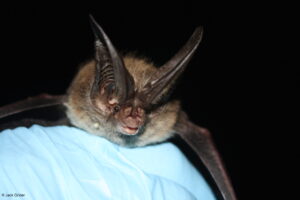Rafinesque’s Big-eared Bat
Scientific Name: Corynorhinus rafinesquii
Description.
Rafinesque’s Big-eared Bat is a medium-sized bat distinguished in appearance by its enormous ears, which measure 27-37mm in length, or about a third the total length of its body. The ears, when curved backwards, resemble a ram’s horns; they are mobile and can be held erect or folded against the head to prevent loss of heat and moisture. In adults, the fur is grayish brown, tipped with white on the belly. Rafinesque’s big-eared bats possess two prominent facial glands that appear as fleshy lumps on either side of the nose, immediately in front of the eyes. The feet have long toe hairs that extend past the claws, a characteristic that distinguishes it from the similar-looking Virginia Big-eared Bat. Another characteristic to distinguish this species from the Virginia Big-eared Bat is the bicolored ventral fur. This species wings are short and broad. Females are slightly heavier than males.
Distribution.
The Rafinesque’s Big-eared Bat is found throughout the southeastern part of the U.S. In North Carolina, there are two subspecies C.r. macrotis which is found in near the coastal plains and the C.r. rafinesquii which is found in the mountains.
Ecology and Behavior.
Rafinesque’s bats roost in caves or hollow trees as well as man-made structures such as abandoned buildings or wells. This species hibernates in groups of males and females which share the same hibernaculum. These bats do not always cluster closely together in the manner of gray bats, but may do so to conserve heat under especially cold conditions. They are sensitive to roost disturbance, which may cause them to abandon an otherwise suitable location. This is particularly damaging for maternity colonies in the summer roosts.
Food and Feeding.
Rafinesque’s Big-eared Bats are moth specialists whose incredible agility allows them to skim or “glean” insects from the surface of foliage. They may also capture prey in flight. Their broad, relatively short wings and lower-pitched feeding calls are ideal tools for feeding within densely vegetated areas such as tree canopies. The species eat many types of insects, but 90% of their diet consist of moths, many of which are known to be agricultural and forest pests.
Reproduction and Development.
Rafinesque’s Big-eared Bats breed once per year. Like all bats in temperate regions mating takes place in the fall, but fertilization does not occur until the end of hibernation in the spring. This adaptation allows for time for fetal development, and then juvenile growth sufficient to enter hibernation. Both sexes will overwinter in the same hibernaculum. Ovulation begins after bats emerge from hibernation, and the stored sperm is used to fertilize the egg. Juvenile bats are born hairless, but grow fur just a few days after birth. They become volant three to four weeks after birth, and shed their milk teeth in mid-July. Following a molt of their juvenile pelage, they will take on adult appearance by late summer. Parental care is exclusively female, and during the summer females with offspring will usually roost in maternity colonies comprised of 30-200 individuals. Males generally choose solitary roosts in summer, or roost with small groups of other males. Juveniles are left in the roost while females fly out to forage. If the mother chooses a new roost, she will carry the nonvolant juvenile on her belly.
Status.
This species is uncommon throughout its range. Though Rafinesque’s Big-eared Bats have tested positive for the presence of fungal spores which cause White-nose Syndrome, there are currently no known records of the disease in this species.
- Click here to see where you can find the Rafinesque’s Big-eared Bat in NC!
